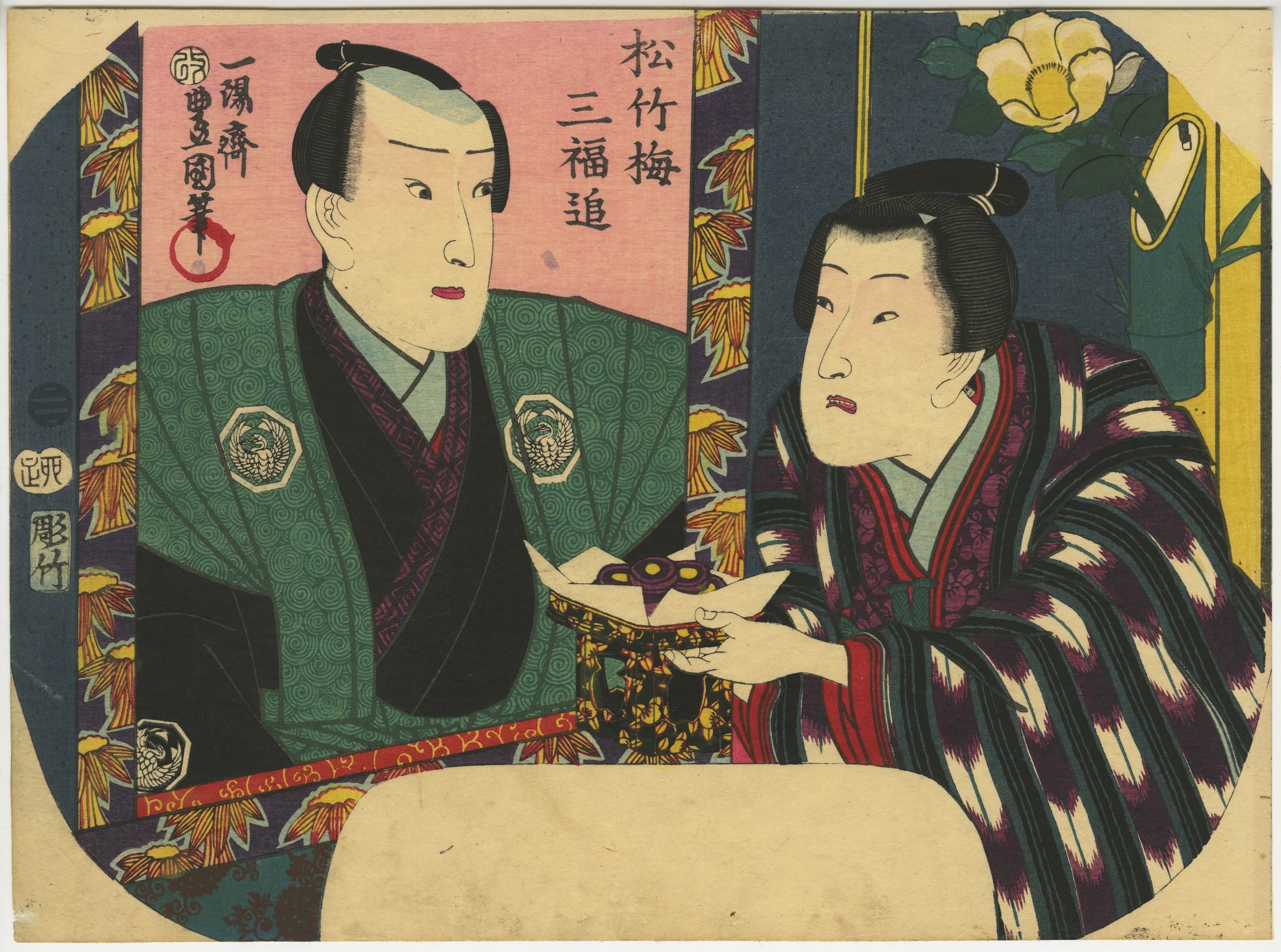"Early signed example of the work of Koike Naomasa. The kiku shape iron plate is well finished. The flush inlay is brass, for the scroll work on both sides, with the leaves and kiri mon in brass, copper and silver with strong detail carving. Some of the inlay goes almost over the edge, which is goishi gata. The large hitsuana are plugged in lead with starburst kokuin surface design. [...]The face is signed in deep bold kanji: Koike Naomasa; the back is signed: Izumi no Kami, on the right and Yoshiro on the left. There are one or two small pieces of inlay missing. Sold by Sotheby London, Oct. 27, 1981, lot 368. Height = 86 mm, thickness (seppa-dai) = 3.75 mm, (edge) = 4 mm."Another similar example presented at: "Tsuba" by Günter Heckmann, 1995, №T55 — "Designation: Koike Naomasa. Mid Edo, end of the 17th century. Iron, hira-zogan in brass, copper, silver and shakudo, katakiri-bori. Tendrils and leaves. 87.0 x 78.0 x 4.0 mm." Reference: Japanische Schwertzierate by Lumir Jisl, 1967, page. 13. [SV: Actually, his tsuba is signed Izumi no Kami Yoshiro on the back; and Koike Naomasa on the front, exactly as Robert Haynes's tsuba. Dating this tsuba Mid-Edo, 17th century may be considered a misattribution]. More details regarding the Yoshirō tsuba.
-
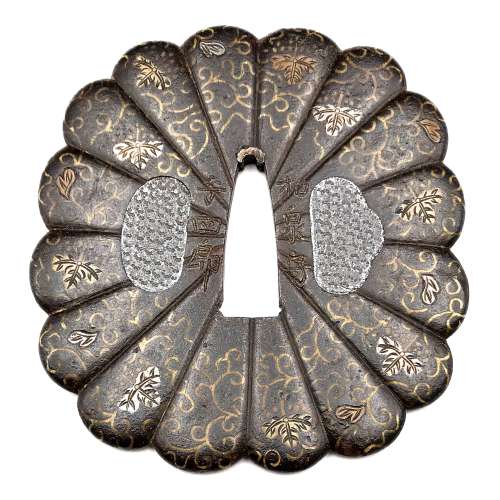 The chrysanthemoid (kiku-gata) iron plate with polished surface decorated with arabesque (karakusa) and paulownia (kiri) leaves and flowers in brass, copper and silver flush inlay (hira-zōgan) on both sides. Some of the inlay goes over the edge. Kozuka- and kogai-hitsu-ana are filled with lead plugs. Sekigane of copper. Chrysanthemum and paulownia are the symbols of imperial family. The face is signed: Izumi no Kami to the right of nakago-ana, and Yoshiro on the left; the back is signed Koike Naomasa. His signed work is considered by many experts to have been made-to-order only. The original wooden box (tomobako) with inscription (hakogaki) signed by Dr. Kazutaro Torigoye and dated Showa 39 (1964). The late Muromachi or Momoyama period, 16th century. Dimensions: 89 mm x 84 mm x 3.6 mm; Weight: 170 g. Hakogaki lid: Yoshirō kikka-gata Hakogaki lid inside: Iron, signed on the omote: Izumi no Kami – Yoshirō; on the ura: Koike Naomasa. Kikka-gata, pronounced maru-mumi, two hitsu-ana, karakusa, and kiri design in brass, silver, and suaka hira-zōgan. Height 8.5 cm, thickness 3.5 mm. Herewith I judge this work as authentic. On a lucky day in July of 1964. Torigoe Kōdō [Kazutarō] + kaō According to Robert Haynes [Catalog #7, 1983; №32, page 42-43] "This full form of the signature is seen very rarely". His example, illustrated in that catalogue, measures: height = 86 mm, thickness at seppa-dai = 3.75 mm and signed Izumi no Kami Yoshiro on the back and Koike Naomasa on the face. The further description of his specimen by Robert Haynes:
The chrysanthemoid (kiku-gata) iron plate with polished surface decorated with arabesque (karakusa) and paulownia (kiri) leaves and flowers in brass, copper and silver flush inlay (hira-zōgan) on both sides. Some of the inlay goes over the edge. Kozuka- and kogai-hitsu-ana are filled with lead plugs. Sekigane of copper. Chrysanthemum and paulownia are the symbols of imperial family. The face is signed: Izumi no Kami to the right of nakago-ana, and Yoshiro on the left; the back is signed Koike Naomasa. His signed work is considered by many experts to have been made-to-order only. The original wooden box (tomobako) with inscription (hakogaki) signed by Dr. Kazutaro Torigoye and dated Showa 39 (1964). The late Muromachi or Momoyama period, 16th century. Dimensions: 89 mm x 84 mm x 3.6 mm; Weight: 170 g. Hakogaki lid: Yoshirō kikka-gata Hakogaki lid inside: Iron, signed on the omote: Izumi no Kami – Yoshirō; on the ura: Koike Naomasa. Kikka-gata, pronounced maru-mumi, two hitsu-ana, karakusa, and kiri design in brass, silver, and suaka hira-zōgan. Height 8.5 cm, thickness 3.5 mm. Herewith I judge this work as authentic. On a lucky day in July of 1964. Torigoe Kōdō [Kazutarō] + kaō According to Robert Haynes [Catalog #7, 1983; №32, page 42-43] "This full form of the signature is seen very rarely". His example, illustrated in that catalogue, measures: height = 86 mm, thickness at seppa-dai = 3.75 mm and signed Izumi no Kami Yoshiro on the back and Koike Naomasa on the face. The further description of his specimen by Robert Haynes: -
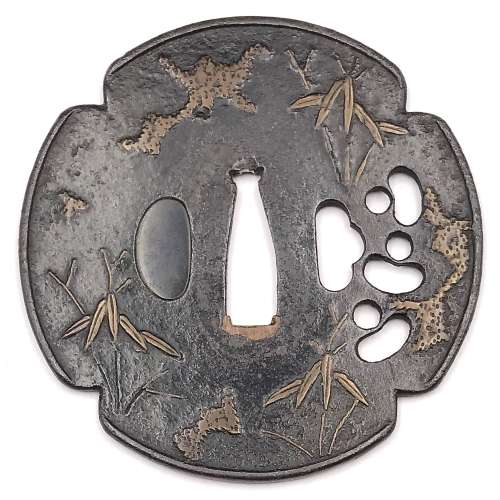 Iron tsuba of four-lobbed mokkō form (possibly it was circular and then altered to produce the mokkō) with slightly raised rim decorated with three kukurizaru ('tied up monkey' toy) in openwork (sukashi) next to kogai-hitsu-ana; inlaid in red-ish copper (suaka) with the design of bamboo stems and leaves, and shapeless masses which most probably represent snow. Kozuka-hitsu-ana plugged with shakudo. Probably original kogai-hitsu-ana. Copper sekigane. Surface still covered with lacquer (urushi). Late Muromachi period (1514-1573). Size: 86.1 x 85.8 x 2.6 mm NBTHK Certificate №4002543: Hozon - "Worthy of preservation" (Attribution: Mumei Heianjō Zōgan)
Iron tsuba of four-lobbed mokkō form (possibly it was circular and then altered to produce the mokkō) with slightly raised rim decorated with three kukurizaru ('tied up monkey' toy) in openwork (sukashi) next to kogai-hitsu-ana; inlaid in red-ish copper (suaka) with the design of bamboo stems and leaves, and shapeless masses which most probably represent snow. Kozuka-hitsu-ana plugged with shakudo. Probably original kogai-hitsu-ana. Copper sekigane. Surface still covered with lacquer (urushi). Late Muromachi period (1514-1573). Size: 86.1 x 85.8 x 2.6 mm NBTHK Certificate №4002543: Hozon - "Worthy of preservation" (Attribution: Mumei Heianjō Zōgan) -
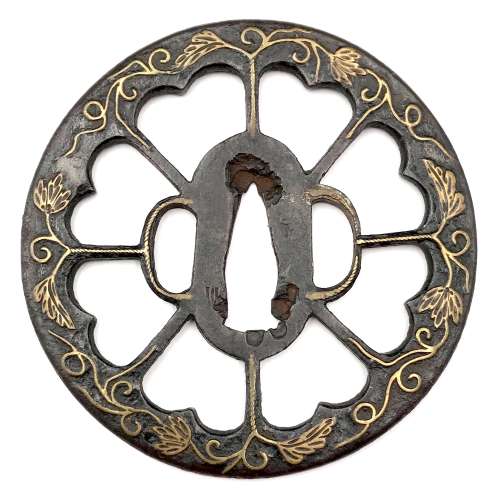 Iron tsuba of round form represents an eight-spoke Wheel-of-the-Law and in the same time (because of the inner shape of cut-outs) - a sixteen-petal imperial chrysanthemum in openwork (sukashi). Decorated on both sides with vines, leaves, and tendrils in suemon-zōgan and sen-zōgan. Spokes and hitsu-ana decorated with rope-like linear brass inlay (nawame-zōgan). A somewhat look-a-like tsuba is referenced in Gary D. Murtha's Japanese Sword Guards. Onin-Heianjo-Yoshiro book on page 61. Mr. Murtha attributes his piece to Heianjo school of Azuchi-Momoyama or early Edo period. However, tsuba in this collection looks older and bolder than the one in his book. It is larger (84 mm vs. his 66 mm), the spokes are longer, the inlay is of better quality, it is relatively thin, with deep black patina, and with the traces of lacquer (urushi). This may indicate that this tsuba belongs to Ōnin school and dates at least to late Muromachi period, ca. 1550, if not 1450 AD. Mid to late Muromachi period (ca. 1450-1550). Dimensions: 84.3 x 83.2 x 3.2 mm "In Japan, the Wheel-of-the-Law is an attribute of such deities as Senju Kannon, the Thousand-Armed Kannon, and Dainichi Nyorai, the principal deity of Shingon Buddhism [Merrily Baird]. May be used as a family crest (mon).
Iron tsuba of round form represents an eight-spoke Wheel-of-the-Law and in the same time (because of the inner shape of cut-outs) - a sixteen-petal imperial chrysanthemum in openwork (sukashi). Decorated on both sides with vines, leaves, and tendrils in suemon-zōgan and sen-zōgan. Spokes and hitsu-ana decorated with rope-like linear brass inlay (nawame-zōgan). A somewhat look-a-like tsuba is referenced in Gary D. Murtha's Japanese Sword Guards. Onin-Heianjo-Yoshiro book on page 61. Mr. Murtha attributes his piece to Heianjo school of Azuchi-Momoyama or early Edo period. However, tsuba in this collection looks older and bolder than the one in his book. It is larger (84 mm vs. his 66 mm), the spokes are longer, the inlay is of better quality, it is relatively thin, with deep black patina, and with the traces of lacquer (urushi). This may indicate that this tsuba belongs to Ōnin school and dates at least to late Muromachi period, ca. 1550, if not 1450 AD. Mid to late Muromachi period (ca. 1450-1550). Dimensions: 84.3 x 83.2 x 3.2 mm "In Japan, the Wheel-of-the-Law is an attribute of such deities as Senju Kannon, the Thousand-Armed Kannon, and Dainichi Nyorai, the principal deity of Shingon Buddhism [Merrily Baird]. May be used as a family crest (mon).
Gary D. Murtha's tsuba on page 61.
-
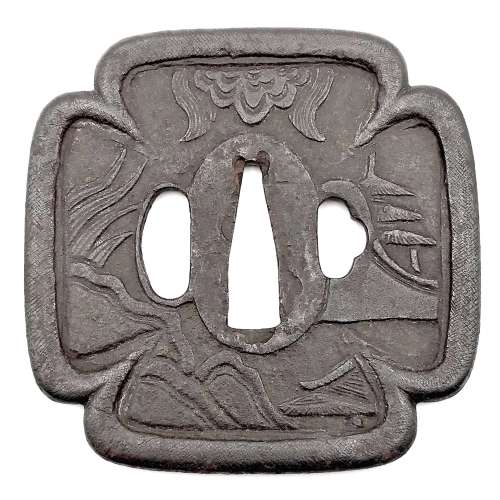 Mokkō-form (kirikomi-mokkō-gata) iron plate of grey colour decorated on both sides with waves, reeds, cloud, pagoda, and thatched hut in low relief (sukidashi-bori). The kozuka-hitsu-ana is original, the kogai-hitsu-ana probably cut later (lacks raised rim, fuchidoru). Wide (5.7 mm) raised rim of rounded square dote-mimi type, decorated with fine cross-hatching. Momoyama period, 16th century. Dimensions: Height: 75.9 mm, width: 76.4 mm, Thickness at seppa-dai: 2.3 mm, at rim 4.4 mm. Kamakura-bori tsuba of such a form is unusual. The rim is also unusual; it is possible that cross-hatching was done as a preparatory step for damascening, or the the damascening (gold or silver) disappeared with passage of time.
Mokkō-form (kirikomi-mokkō-gata) iron plate of grey colour decorated on both sides with waves, reeds, cloud, pagoda, and thatched hut in low relief (sukidashi-bori). The kozuka-hitsu-ana is original, the kogai-hitsu-ana probably cut later (lacks raised rim, fuchidoru). Wide (5.7 mm) raised rim of rounded square dote-mimi type, decorated with fine cross-hatching. Momoyama period, 16th century. Dimensions: Height: 75.9 mm, width: 76.4 mm, Thickness at seppa-dai: 2.3 mm, at rim 4.4 mm. Kamakura-bori tsuba of such a form is unusual. The rim is also unusual; it is possible that cross-hatching was done as a preparatory step for damascening, or the the damascening (gold or silver) disappeared with passage of time.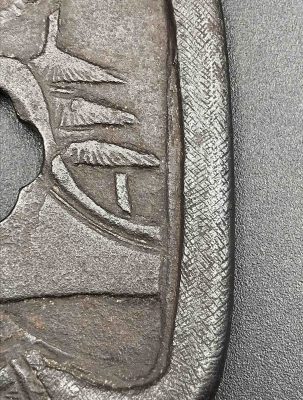
-
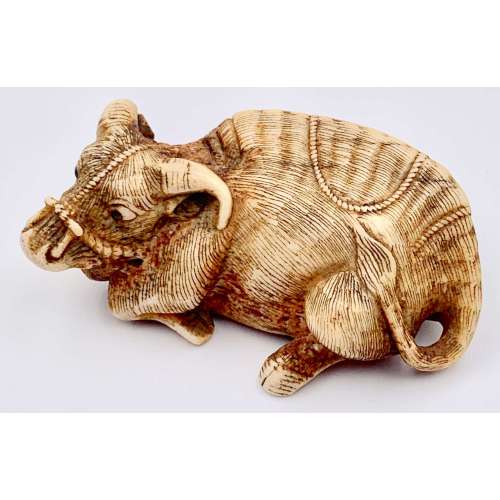 Stag antler netsuke of a recumbent ox. Signed: Tomomasa [友政]. Circa 1800. Dimensions: 56.1 x 20.7 x 36.8 mm Just speculation: There was a master in Kyoto named Tomotada who made netsuke with a recumbent ox motif. Our Tomomasa may be an epigone of a later date. Some even attribute the master to Meiji period. Provenance: Charles Ephrussi (1849-1905) acquired in the 1870s; a wedding gift in 1898 to his cousin Ritter Viktor von Ephrussi (1860-1945) and Baroness Emilie (Emmy) Schey von Koromla (1879-1938); retrieved post-war by their daughter Elizabeth de Waal (1899-1991); given by her to her brother Ignaz (Iggie) Ephrussi (1906-1994), Tokyo; bequeathed by him to his great-nephew Edmund de Waal (born 1964), London, author of “The Hare with Amber Eyes: a hidden inheritance”. London / New York: Chatto & Windus / Farrar, Straus & Giroux. ISBN 978-0099539551. https://en.wikipedia.org/wiki/Charles_Ephrussi. https://en.wikipedia.org/wiki/Ephrussi_family. https://en.wikipedia.org/wiki/Edmund_de_Waal.
Stag antler netsuke of a recumbent ox. Signed: Tomomasa [友政]. Circa 1800. Dimensions: 56.1 x 20.7 x 36.8 mm Just speculation: There was a master in Kyoto named Tomotada who made netsuke with a recumbent ox motif. Our Tomomasa may be an epigone of a later date. Some even attribute the master to Meiji period. Provenance: Charles Ephrussi (1849-1905) acquired in the 1870s; a wedding gift in 1898 to his cousin Ritter Viktor von Ephrussi (1860-1945) and Baroness Emilie (Emmy) Schey von Koromla (1879-1938); retrieved post-war by their daughter Elizabeth de Waal (1899-1991); given by her to her brother Ignaz (Iggie) Ephrussi (1906-1994), Tokyo; bequeathed by him to his great-nephew Edmund de Waal (born 1964), London, author of “The Hare with Amber Eyes: a hidden inheritance”. London / New York: Chatto & Windus / Farrar, Straus & Giroux. ISBN 978-0099539551. https://en.wikipedia.org/wiki/Charles_Ephrussi. https://en.wikipedia.org/wiki/Ephrussi_family. https://en.wikipedia.org/wiki/Edmund_de_Waal. -
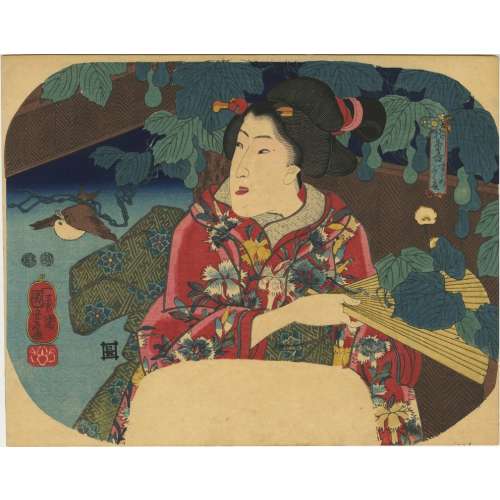 Artist: Utagawa Kuniyoshi [歌川 國芳] (Japanese, 1798 – 1861).
Artist: Utagawa Kuniyoshi [歌川 國芳] (Japanese, 1798 – 1861).Title: Suzume fukube [美人団扇絵] (Sparrow and gourds).
Series: Kacho awase [花鳥合] (Collection of flowers and birds).
Publisher: Aritaya Seiemon [有田屋 清右衛門] (Japanese, fl. c. 1830 – 1862); Seal: Marks 17-011 | 014d.Signed: Ichiyosai Kuniyoshi ga in a red cartouche and sealed with paulownia crest (kiri mon).
Size: Uchiwa-e (untrimmed fan print) 296 x 230 mm.
Double nanushi censor seals: Kinugasa & Watanabe, Kaei 2-3 (1849–50).
Ref.: Kuniyoshi Project. -
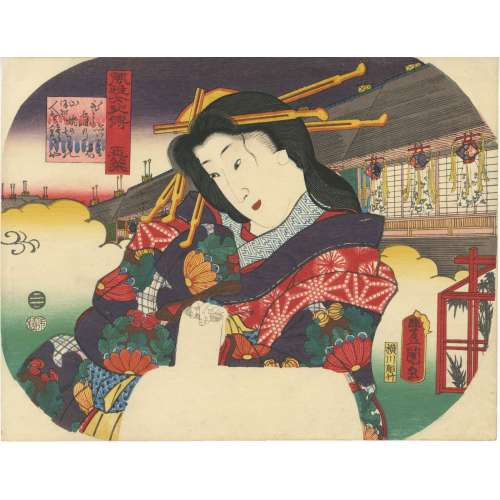 Artist: Utagawa Kunisada [歌川 国貞], a.k.a. Utagawa Toyokuni III [三代 歌川 豊国] (Japanese, 1786 – 1865). Signed: Toyokuni ga [豊国 画] in a red toshidama cartouche Block carver: Yokokawa Takejirō [横川竹二郎] (Japanese, fl. 1845 – 1863), seal: 彫竹 – hori Take. Publisher: Ibaya Senzaburō [伊場屋仙三郎] (Japanese, fl. c. 1845 – 1847). Media: Untrimmed fan print (uchiwa-e), 232 x 300 mm. Title: Tamagiku [玉菜]. Series: Chronicles of Elegant Women [風雅女史傳] (Fūga joshiden). Combined date seal and kiwame censor seal: Ansei 6 (1859). Other prints from the same series in this collection [SVJP-0216.2016] — Princess Sotoori:
Artist: Utagawa Kunisada [歌川 国貞], a.k.a. Utagawa Toyokuni III [三代 歌川 豊国] (Japanese, 1786 – 1865). Signed: Toyokuni ga [豊国 画] in a red toshidama cartouche Block carver: Yokokawa Takejirō [横川竹二郎] (Japanese, fl. 1845 – 1863), seal: 彫竹 – hori Take. Publisher: Ibaya Senzaburō [伊場屋仙三郎] (Japanese, fl. c. 1845 – 1847). Media: Untrimmed fan print (uchiwa-e), 232 x 300 mm. Title: Tamagiku [玉菜]. Series: Chronicles of Elegant Women [風雅女史傳] (Fūga joshiden). Combined date seal and kiwame censor seal: Ansei 6 (1859). Other prints from the same series in this collection [SVJP-0216.2016] — Princess Sotoori: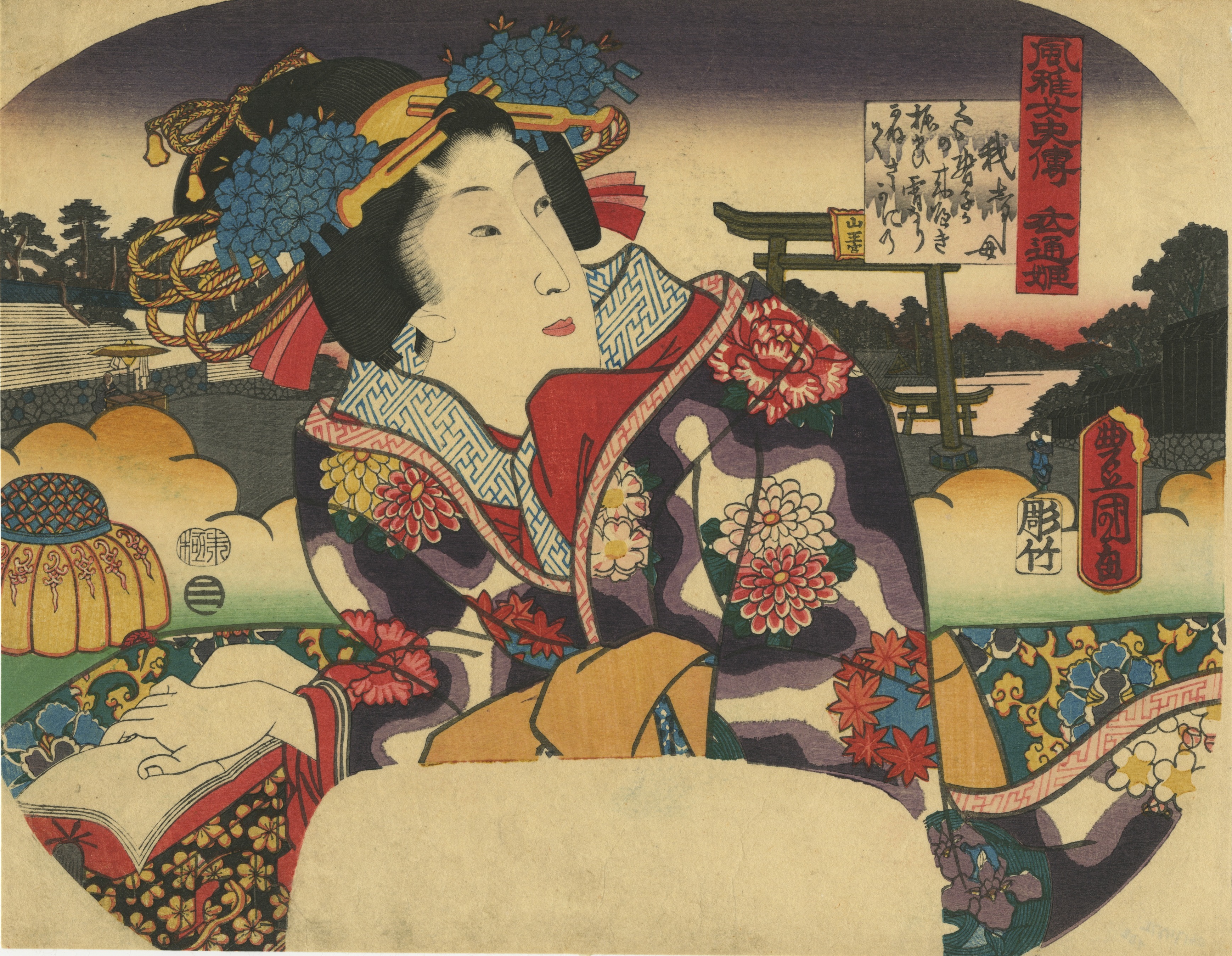 SVJP-0400.2023 — Saiko:
SVJP-0400.2023 — Saiko:
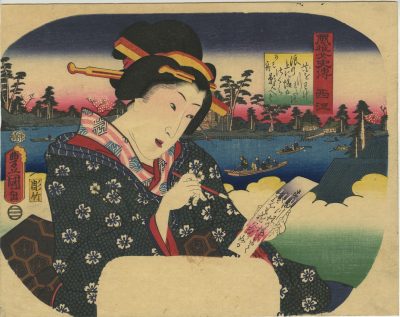 Note by Elena Varshavsky:
Tamagiku [玉菜] (Japanese, 1702 – 1726) – Precious Chrysanthemum (translated also as Jade Chrysanthemum; one can say also Gem Chrysanthemum). She was a courtesan famous for her beauty, kind heart, and countless artistic accomplishments. She died young and was deeply grieved by the establishment of Nakamanji-ya (中万字屋) for which she worked, and beyond. Her memory was celebrated during the Bon festival of the commemoration of the dead, and lanterns were hung at the gallery of that establishment and other neighbouring ones to commemorate her and appease her soul. These lanterns are seen behind her. Kabuki plays were continuously dedicated to her, she figured in Edo period literature and was often portrayed on ukiyo-e prints. In many cases, she was shown with the lanterns associated with her. Those lanterns were called “Tamagiku Lanterns”.
Other depictions of Tamagiku:
Note by Elena Varshavsky:
Tamagiku [玉菜] (Japanese, 1702 – 1726) – Precious Chrysanthemum (translated also as Jade Chrysanthemum; one can say also Gem Chrysanthemum). She was a courtesan famous for her beauty, kind heart, and countless artistic accomplishments. She died young and was deeply grieved by the establishment of Nakamanji-ya (中万字屋) for which she worked, and beyond. Her memory was celebrated during the Bon festival of the commemoration of the dead, and lanterns were hung at the gallery of that establishment and other neighbouring ones to commemorate her and appease her soul. These lanterns are seen behind her. Kabuki plays were continuously dedicated to her, she figured in Edo period literature and was often portrayed on ukiyo-e prints. In many cases, she was shown with the lanterns associated with her. Those lanterns were called “Tamagiku Lanterns”.
Other depictions of Tamagiku:
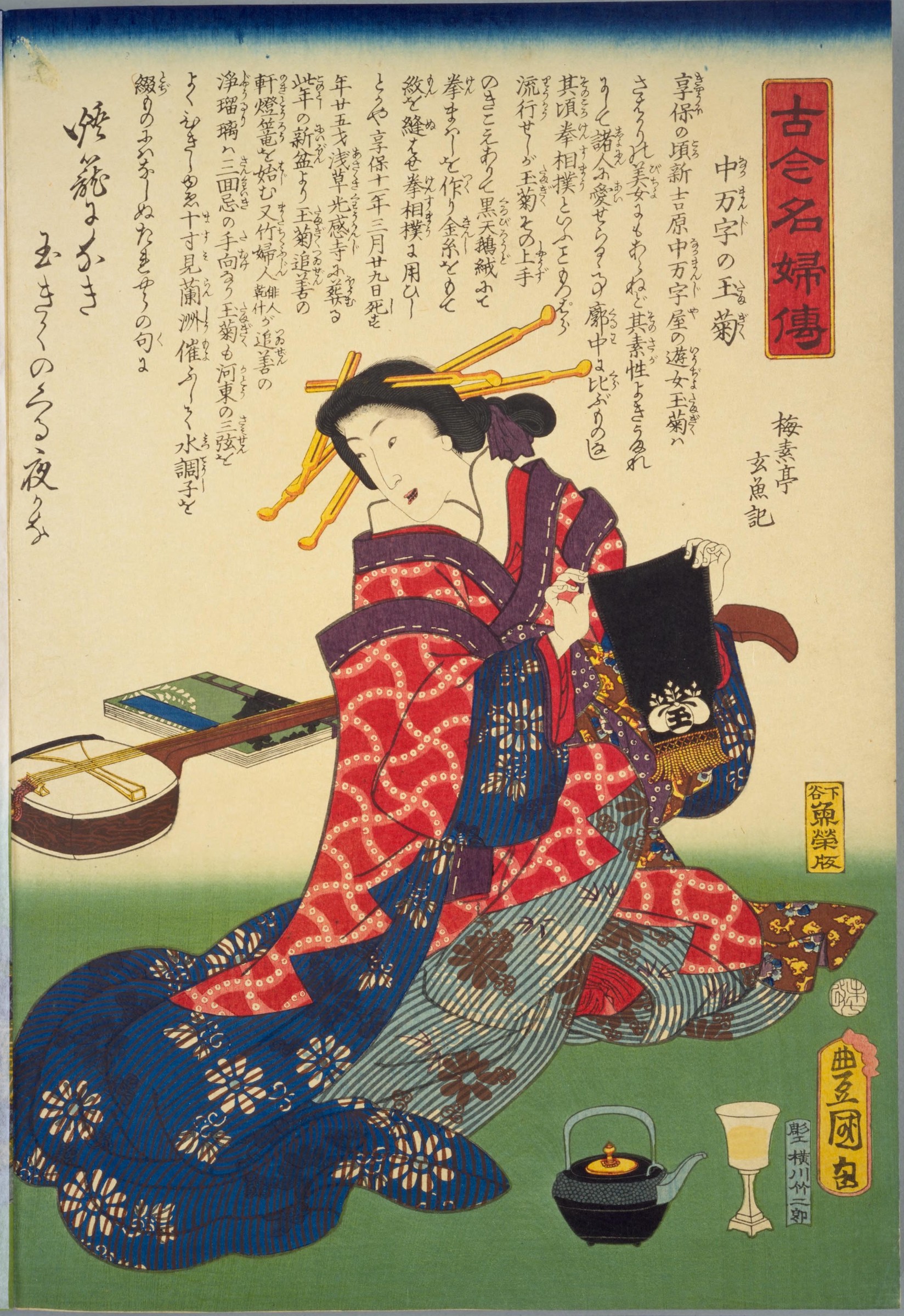
Tamagiku (Ancient and modern women's biography) by Kunisada, 1859.
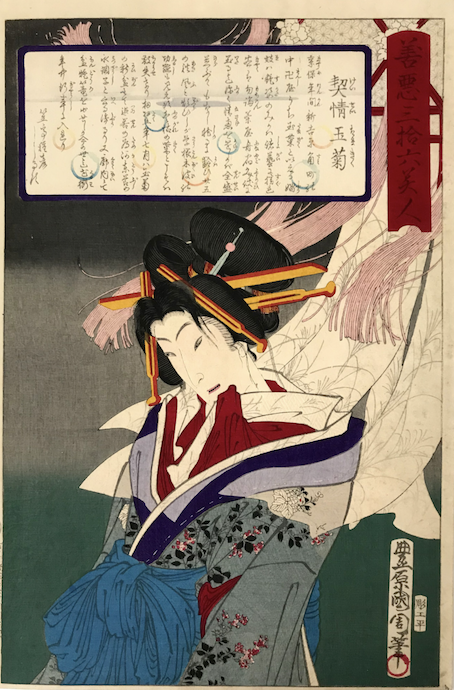
Courtesan Tamagiku by Kunichika.
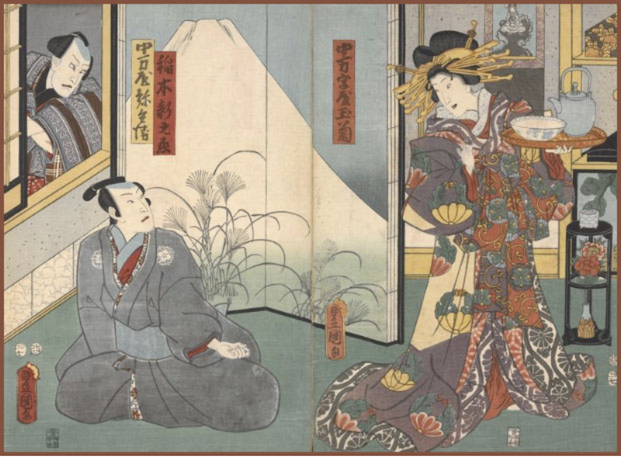
Tamagiku of the Nakamanjiya, Inaki Shinnojō, and Nakamanjiya Yahei (looking through the window) by Kunisada.

Nakamanji-Ya Tamagiku by Kunisada
Sources: darumapedia; kajiipeta; kabuki21; crosseyedgallery.
Nakamanji-Ya Tamagiku by Kunisada, 1857
-
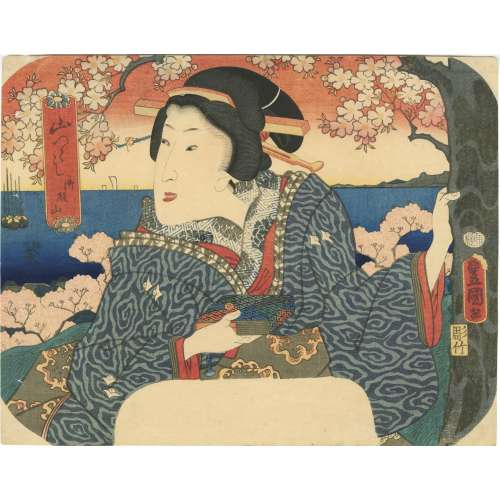 Title: Gotenyama [御殿山] – one of the most popular cherry blossom viewing spots; it is a hill at Shinagawa [品川], the second station on the Tōkaidō road [東海道], located on the shores of Edo Bay [江戸湾]. Series: A Collection of Mountains [山つくし] (Yama tsukushi) Artist: Utagawa Kunisada [歌川 国貞] a.k.a. Utagawa Toyokuni III [三代歌川豊国] (Japanese, 1786 – 12 January 1865). Block carver: Yokokawa Takejirō, seal: [彫竹] – Hori Take. Publisher: Yama-Ta; seal: [板元, 太] – Hanmoto, Ta; Marks 19-044 | U421b: An unknown publisher in Edo, fl. c. 1815-61. Combined date seal and kiwame censor seal: Ansei 6 (1851). Signed: Toyokuni ga [豊国 画] in a red toshidama cartouche. Size: Fan print (uchiwa-e) 227 x 287 mm.
Title: Gotenyama [御殿山] – one of the most popular cherry blossom viewing spots; it is a hill at Shinagawa [品川], the second station on the Tōkaidō road [東海道], located on the shores of Edo Bay [江戸湾]. Series: A Collection of Mountains [山つくし] (Yama tsukushi) Artist: Utagawa Kunisada [歌川 国貞] a.k.a. Utagawa Toyokuni III [三代歌川豊国] (Japanese, 1786 – 12 January 1865). Block carver: Yokokawa Takejirō, seal: [彫竹] – Hori Take. Publisher: Yama-Ta; seal: [板元, 太] – Hanmoto, Ta; Marks 19-044 | U421b: An unknown publisher in Edo, fl. c. 1815-61. Combined date seal and kiwame censor seal: Ansei 6 (1851). Signed: Toyokuni ga [豊国 画] in a red toshidama cartouche. Size: Fan print (uchiwa-e) 227 x 287 mm. -
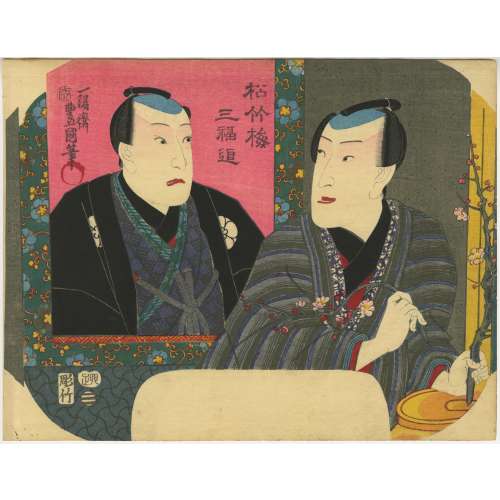 Artist: Utagawa Kunisada [歌川 国貞] a.k.a. Utagawa Toyokuni III [三代歌川豊国] (Japanese, 1786 – 1865). Signed: Ichiyōsai Toyokuni hitsu [一陽斎豊国筆]. Inscriptions: [松竹梅] Shochikubai = pine (matsu, 松), bamboo (take, 竹), and plum (ume, 梅) – an auspicious grouping known as "The Three Friends of Winter"; [三福追] (Sanpuku tsui) – the three delights, or pleasures. Date seal and aratame censor seal: Ansei 2, 1st month (1855). Publisher: Ibaya Senzaburō [伊場屋仙三郎] (Japanese, c. 1815 – 1869). Block carver: Yokokawa Takejirō [横川竹二郎] (Japanese, fl. 1845 – 1863); seal: Hori Take [彫竹]. Kabuki actor Nakamura Shikan IV [中村芝翫] (Nakamura Fukusuke I [中村福助], Nakamura Masanosuke I, Nakamura Komasaburō, Nakamura Tamatarō I, Japanese, 1831 – 1899) arranging a branch of blossoming plum to the memorial portrait of his predecessor Nakamura Utaemon IV [中村歌右衛門] (Nakamura Shikan II, Nakamura Tsurusuke I, Nakamura Tōtarō, Japanese, 1796 – 1852); the latter is dressed in a black robe adorned with a mokkō-crest (mon) of white plum blossom, the hanging scroll border decorated with arabesque and plum blossoms. Actors identified by Horst Graebner. Two fan prints from this series in Varshavsky Collection:
Artist: Utagawa Kunisada [歌川 国貞] a.k.a. Utagawa Toyokuni III [三代歌川豊国] (Japanese, 1786 – 1865). Signed: Ichiyōsai Toyokuni hitsu [一陽斎豊国筆]. Inscriptions: [松竹梅] Shochikubai = pine (matsu, 松), bamboo (take, 竹), and plum (ume, 梅) – an auspicious grouping known as "The Three Friends of Winter"; [三福追] (Sanpuku tsui) – the three delights, or pleasures. Date seal and aratame censor seal: Ansei 2, 1st month (1855). Publisher: Ibaya Senzaburō [伊場屋仙三郎] (Japanese, c. 1815 – 1869). Block carver: Yokokawa Takejirō [横川竹二郎] (Japanese, fl. 1845 – 1863); seal: Hori Take [彫竹]. Kabuki actor Nakamura Shikan IV [中村芝翫] (Nakamura Fukusuke I [中村福助], Nakamura Masanosuke I, Nakamura Komasaburō, Nakamura Tamatarō I, Japanese, 1831 – 1899) arranging a branch of blossoming plum to the memorial portrait of his predecessor Nakamura Utaemon IV [中村歌右衛門] (Nakamura Shikan II, Nakamura Tsurusuke I, Nakamura Tōtarō, Japanese, 1796 – 1852); the latter is dressed in a black robe adorned with a mokkō-crest (mon) of white plum blossom, the hanging scroll border decorated with arabesque and plum blossoms. Actors identified by Horst Graebner. Two fan prints from this series in Varshavsky Collection: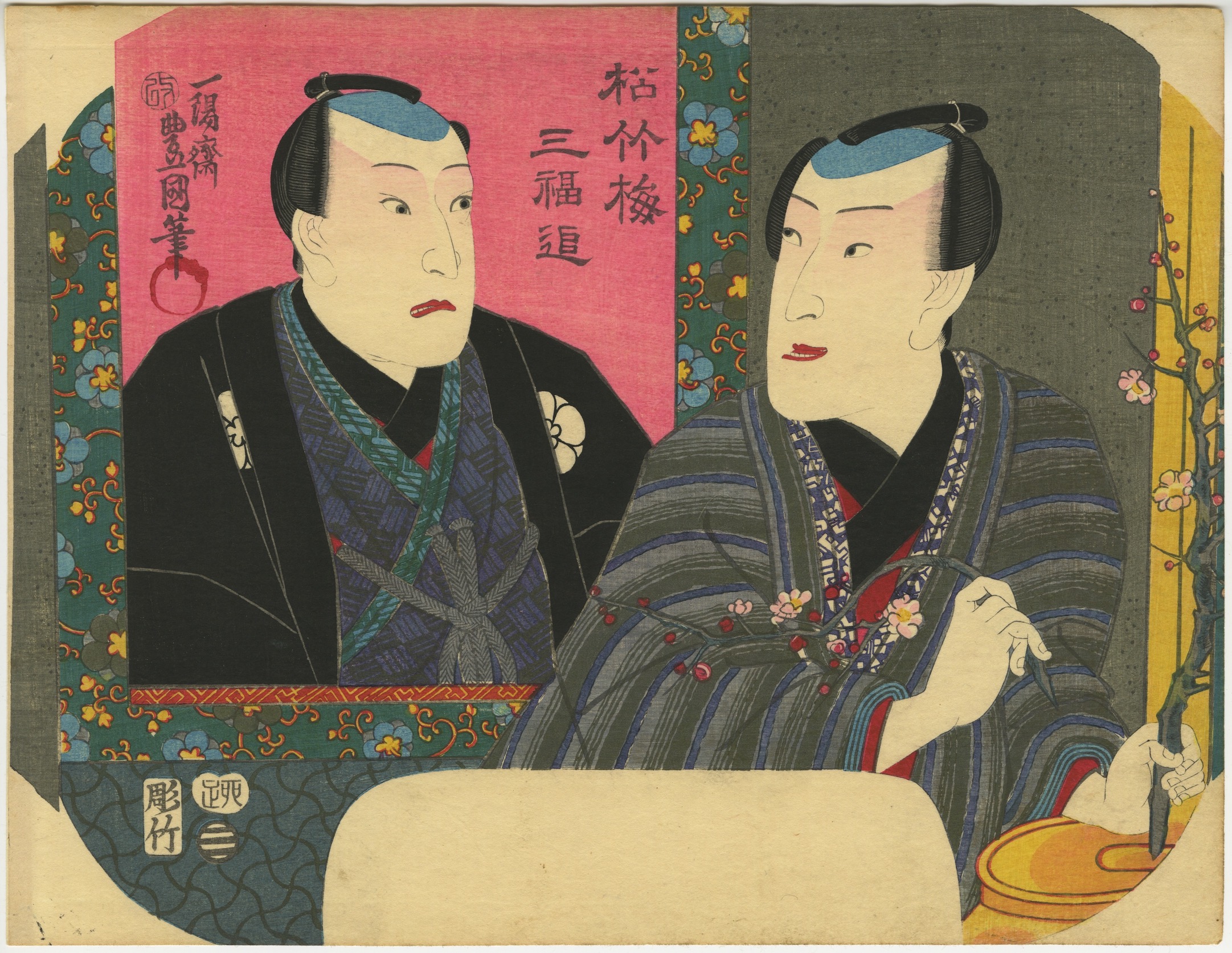
SVJP-0336.2021
-
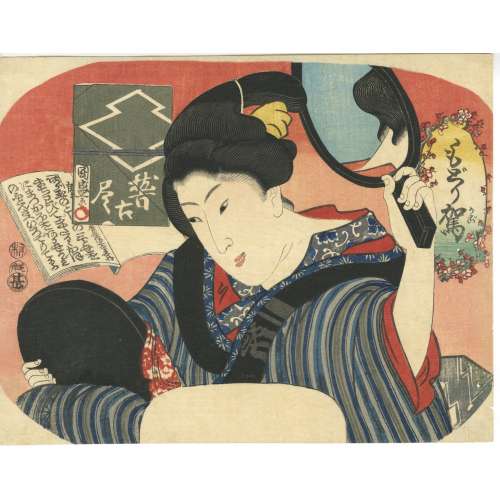 Title: Modori Kago [戻駕] (Returning palanquin). The dance-drama Modori Kago Iro ni Aikata [戻駕色相肩] premiered in the 11th lunar month of 1788 at the Nakamuraza [中村座], within Sakurada Jisuke I's kaomise [顔見世] (faceshowing) program Tôzumô Hana no Edogata [唐相撲花江戸方]", which celebrated the homecoming to Edo, after two years' absence, of Nakamura Nakazō I, and was intended to show off his particular talents in the role of Jirosaku (in reality Ishikawa Goemon [石川 五右衛門]) [kabuki21]. The symbol on a green book cover is the informal crest of tokiwazu-bushi [常磐津節] shaped like a water chestnut (Eleocharis dulcis) lozenge. Artist signature 国盛画 (Kunimori ga) with red toshidama. According to Samuel L. Leiter’s Kabuki Encyclopedia (1979), p. 243: The palanquin bearers Nanpa no Jirosaku and Azuma no Yōshirō, who are bearing a palanquin with a courtesan's young handmaiden in it, stop to rest at Kyoto's Murasakino, and each dances his regional dance. Then they call the girl, who does a dance showing the visitors to the famous pleasure quarters, Yoshiwara and Shimabara. The two men recognize each other as Ishikawa Goemon and Masashiba Hisayoshi, sworn enemies, and engage in a fight. This number is the only remaining section of an annual "faceshowing” (kaomize) work with a plot based on the medieval chronicle called the Toikōki. The full-length piece was called Kara Sumō Hanaeda no Kata. It is one of the most famous tokiwazu pieces and preserves the old-style Kabuki flavour. Nakamura Nakazō I played Jirosaku and Matsumoto Kōshirō IV was Yoshiro in the first production. The handmaiden was Matsumoto Komesaburō (probably Matsumoto Komasaburō I, an unknown actor [SV]). According to Egenolf Gallery: This work was first performed in 1788 at the Edo Nakamura-za as the season’s first performance and featured Nakamura Nakazō, who returned to Edo after three years in Osaka. It was a dance with tokiwazu chanting and was designed for him to play the lead role. In the piece, two palanquin carriers, one from Osaka, another from Edo, and a passenger – a kamuro, (a young geisha-in-training) exchange stories about the pleasure quarters of Shimabara and Yoshiwara. The text of the chanting book is open next to her, carrying the title “Collection of Practicing” [稽古尽くし], on which the green bundle cover carries the crest of Tokiwazu School, matsu-kawa-bishi, diamond variety of pine bark and the artist’s signature. Tokiwazu is a type of jōruri, narrative music, and accompanies dancing on the kabuki stage. Ref.: Christie's 27 Mar 2006. Publisher: Maruya Jinpachi, seal Marujin (Marks: 12-029 | 294e) Single nanushi censor seal: Mura (Murata Sahei, 1842-46). Provenance: Circular seal of the collector Huguette Bérès to verso. Contributors: Utagawa Kunimori [歌川国盛] (Japanese, fl. c. 1818 – 1943) – artist. Maruya Jinpachi [丸屋甚八] (Japanese, fl. 1770 – 1842) – publisher. Other mentioned: Nakamura Nakazō I [中村仲蔵] (Japanese, 1736 – 1790); other names: Nakayama Kojūrō VI, Nakamura Ichijūrō, Nakayama Manzō – actor. Matsumoto Kōshirō IV [松本幸四郎] (Japanese, 1737 – 1802); other names: Omegawa Kyōjūrō; Ichikawa Komazō II, Ichikawa Somegorô I, Ichikawa Takejūrō ; Segawa Kinji; Segawa Kingo – actor. Sakurada Jisuke I [桜田治助] (Japanese, 1734 – 1806) – dramatist.
Title: Modori Kago [戻駕] (Returning palanquin). The dance-drama Modori Kago Iro ni Aikata [戻駕色相肩] premiered in the 11th lunar month of 1788 at the Nakamuraza [中村座], within Sakurada Jisuke I's kaomise [顔見世] (faceshowing) program Tôzumô Hana no Edogata [唐相撲花江戸方]", which celebrated the homecoming to Edo, after two years' absence, of Nakamura Nakazō I, and was intended to show off his particular talents in the role of Jirosaku (in reality Ishikawa Goemon [石川 五右衛門]) [kabuki21]. The symbol on a green book cover is the informal crest of tokiwazu-bushi [常磐津節] shaped like a water chestnut (Eleocharis dulcis) lozenge. Artist signature 国盛画 (Kunimori ga) with red toshidama. According to Samuel L. Leiter’s Kabuki Encyclopedia (1979), p. 243: The palanquin bearers Nanpa no Jirosaku and Azuma no Yōshirō, who are bearing a palanquin with a courtesan's young handmaiden in it, stop to rest at Kyoto's Murasakino, and each dances his regional dance. Then they call the girl, who does a dance showing the visitors to the famous pleasure quarters, Yoshiwara and Shimabara. The two men recognize each other as Ishikawa Goemon and Masashiba Hisayoshi, sworn enemies, and engage in a fight. This number is the only remaining section of an annual "faceshowing” (kaomize) work with a plot based on the medieval chronicle called the Toikōki. The full-length piece was called Kara Sumō Hanaeda no Kata. It is one of the most famous tokiwazu pieces and preserves the old-style Kabuki flavour. Nakamura Nakazō I played Jirosaku and Matsumoto Kōshirō IV was Yoshiro in the first production. The handmaiden was Matsumoto Komesaburō (probably Matsumoto Komasaburō I, an unknown actor [SV]). According to Egenolf Gallery: This work was first performed in 1788 at the Edo Nakamura-za as the season’s first performance and featured Nakamura Nakazō, who returned to Edo after three years in Osaka. It was a dance with tokiwazu chanting and was designed for him to play the lead role. In the piece, two palanquin carriers, one from Osaka, another from Edo, and a passenger – a kamuro, (a young geisha-in-training) exchange stories about the pleasure quarters of Shimabara and Yoshiwara. The text of the chanting book is open next to her, carrying the title “Collection of Practicing” [稽古尽くし], on which the green bundle cover carries the crest of Tokiwazu School, matsu-kawa-bishi, diamond variety of pine bark and the artist’s signature. Tokiwazu is a type of jōruri, narrative music, and accompanies dancing on the kabuki stage. Ref.: Christie's 27 Mar 2006. Publisher: Maruya Jinpachi, seal Marujin (Marks: 12-029 | 294e) Single nanushi censor seal: Mura (Murata Sahei, 1842-46). Provenance: Circular seal of the collector Huguette Bérès to verso. Contributors: Utagawa Kunimori [歌川国盛] (Japanese, fl. c. 1818 – 1943) – artist. Maruya Jinpachi [丸屋甚八] (Japanese, fl. 1770 – 1842) – publisher. Other mentioned: Nakamura Nakazō I [中村仲蔵] (Japanese, 1736 – 1790); other names: Nakayama Kojūrō VI, Nakamura Ichijūrō, Nakayama Manzō – actor. Matsumoto Kōshirō IV [松本幸四郎] (Japanese, 1737 – 1802); other names: Omegawa Kyōjūrō; Ichikawa Komazō II, Ichikawa Somegorô I, Ichikawa Takejūrō ; Segawa Kinji; Segawa Kingo – actor. Sakurada Jisuke I [桜田治助] (Japanese, 1734 – 1806) – dramatist. -
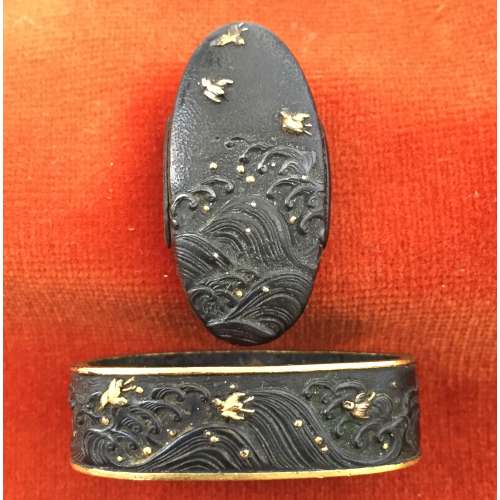 Fuchi: 37 x 21 x 11 mm; Weight: 13 g Kashira: 34 x 16 x 6 mm ; Weight: 10 g Material : Shakudo; Gold. Signature: Unsigned Technique: Sunameji Sukibori Zogan Decoration: Nami Chidori zu (wave & plover)
Fuchi: 37 x 21 x 11 mm; Weight: 13 g Kashira: 34 x 16 x 6 mm ; Weight: 10 g Material : Shakudo; Gold. Signature: Unsigned Technique: Sunameji Sukibori Zogan Decoration: Nami Chidori zu (wave & plover) -
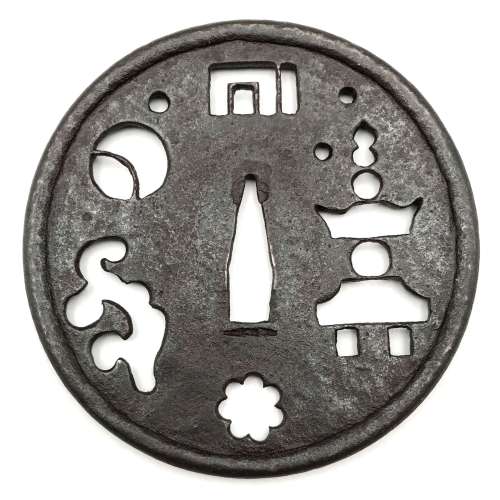 Iron tsuba of round form decorated with design of moon, stars, cloud, snowflake, gorintō, and Genji-mon in negative openwork (in-sukashi). Raised tubular rim (dote-mimi). Deep black patina, traces of lacquer. Naka-daka type of plate (thicker in center, getting thiner towards the rim). Visible gap between the rim and the plate. Dimensions: Height: 91.7 mm; Width: 90.8 mm; Thickness at seppa-dai: 2.5 mm, plate before rim: 2.2 mm, of the rim: 5.6 mm. At least Mid Muromachi period, 15th century, but possibly earlier. In 'Silver Book', commenting tsuba №34 Sasano writes: "The technique used to create the rim is the same used for the peak (koshimaki) of helmets (kabuto) during the Kamakura and Nanbokucho periods." On the other hand, the abundance of sukashi elements points towards later times, perhaps late Muromachi or even Momoyama period. "Gorintō is a grave stone composed of five pieces, piled on one the other, representing, from the bottom upward, earth, water, fire, wind, and heaven, respectively" [Nihon Tō Kōza, Volume VI, Part 1. AFU, 1993, p. 6. / LIB-1554]. A romantic description of the piece may look like this: The air is scented (incense symbol); it's a graveyard, marked by gorintō; a winter (snowflake) evening or night (moon, stars); mist is rising from a ravine towards moon. I did not manage to find a katchūshi piece of this design, only a few Kamakura-bori tsuba:
Iron tsuba of round form decorated with design of moon, stars, cloud, snowflake, gorintō, and Genji-mon in negative openwork (in-sukashi). Raised tubular rim (dote-mimi). Deep black patina, traces of lacquer. Naka-daka type of plate (thicker in center, getting thiner towards the rim). Visible gap between the rim and the plate. Dimensions: Height: 91.7 mm; Width: 90.8 mm; Thickness at seppa-dai: 2.5 mm, plate before rim: 2.2 mm, of the rim: 5.6 mm. At least Mid Muromachi period, 15th century, but possibly earlier. In 'Silver Book', commenting tsuba №34 Sasano writes: "The technique used to create the rim is the same used for the peak (koshimaki) of helmets (kabuto) during the Kamakura and Nanbokucho periods." On the other hand, the abundance of sukashi elements points towards later times, perhaps late Muromachi or even Momoyama period. "Gorintō is a grave stone composed of five pieces, piled on one the other, representing, from the bottom upward, earth, water, fire, wind, and heaven, respectively" [Nihon Tō Kōza, Volume VI, Part 1. AFU, 1993, p. 6. / LIB-1554]. A romantic description of the piece may look like this: The air is scented (incense symbol); it's a graveyard, marked by gorintō; a winter (snowflake) evening or night (moon, stars); mist is rising from a ravine towards moon. I did not manage to find a katchūshi piece of this design, only a few Kamakura-bori tsuba: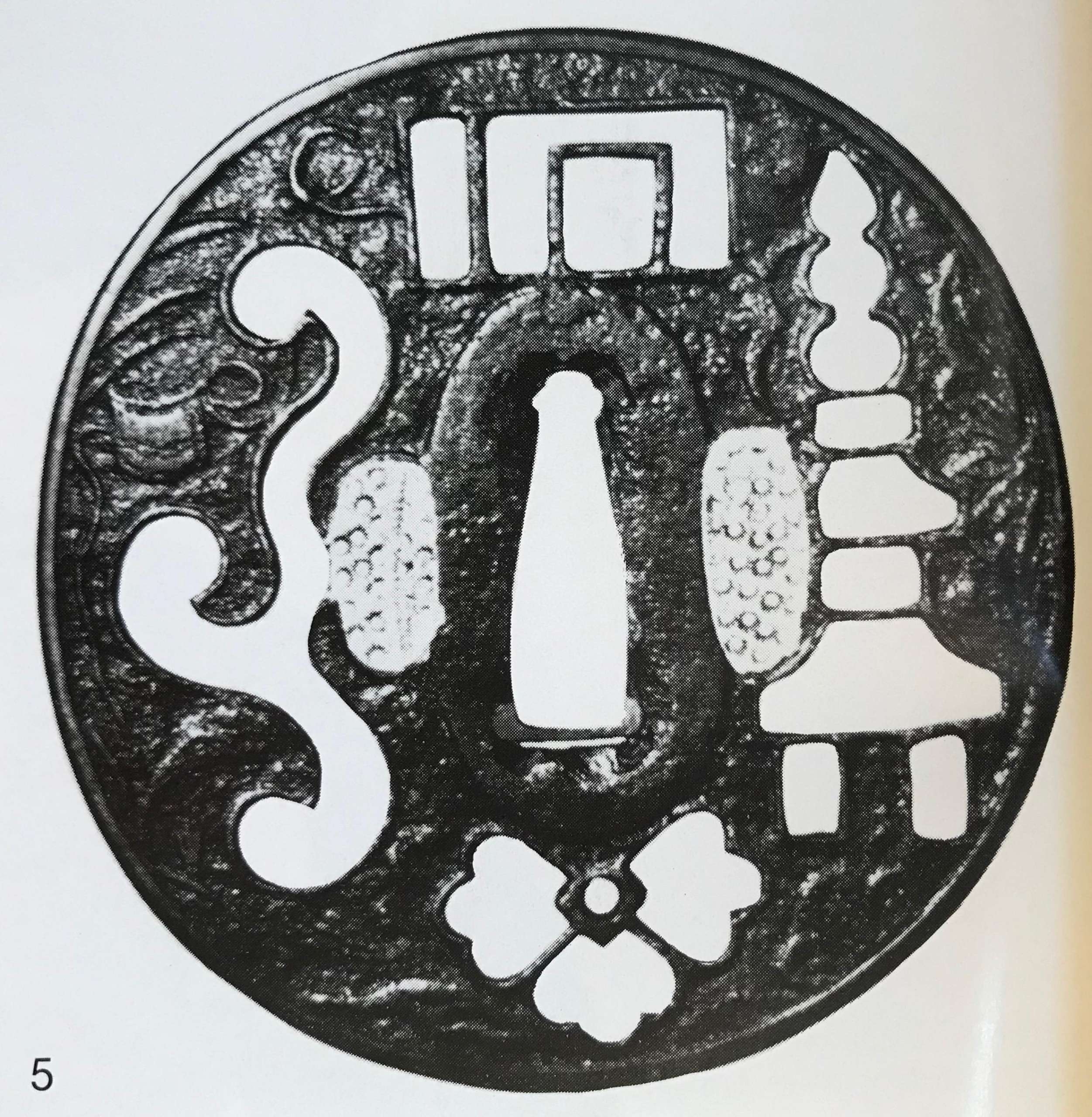
100 selected tsuba from European collections. Catalogue by Robert Haynes and Robert Burawoy, 1984, page 16, №5.
While the upper tsuba is dated the end of Muromachi, the lower is attributed to the 17th century - Momoyama or early Edo period, though the author put this attribution under question. Deciphering of the strangely shaped opening to the left of nakago-ana is sometimes "a conventional scroll", and sometimes - a fern or bracken. I think mine is a cloud or mist, but I don't have any material evidence to prove this understanding, and I came to a conclusion based only on context. It may easily be dinosaurs playing ball. The fact that this thing always accompanies the Genji-mon, or incense symbol, it may be a scent itself.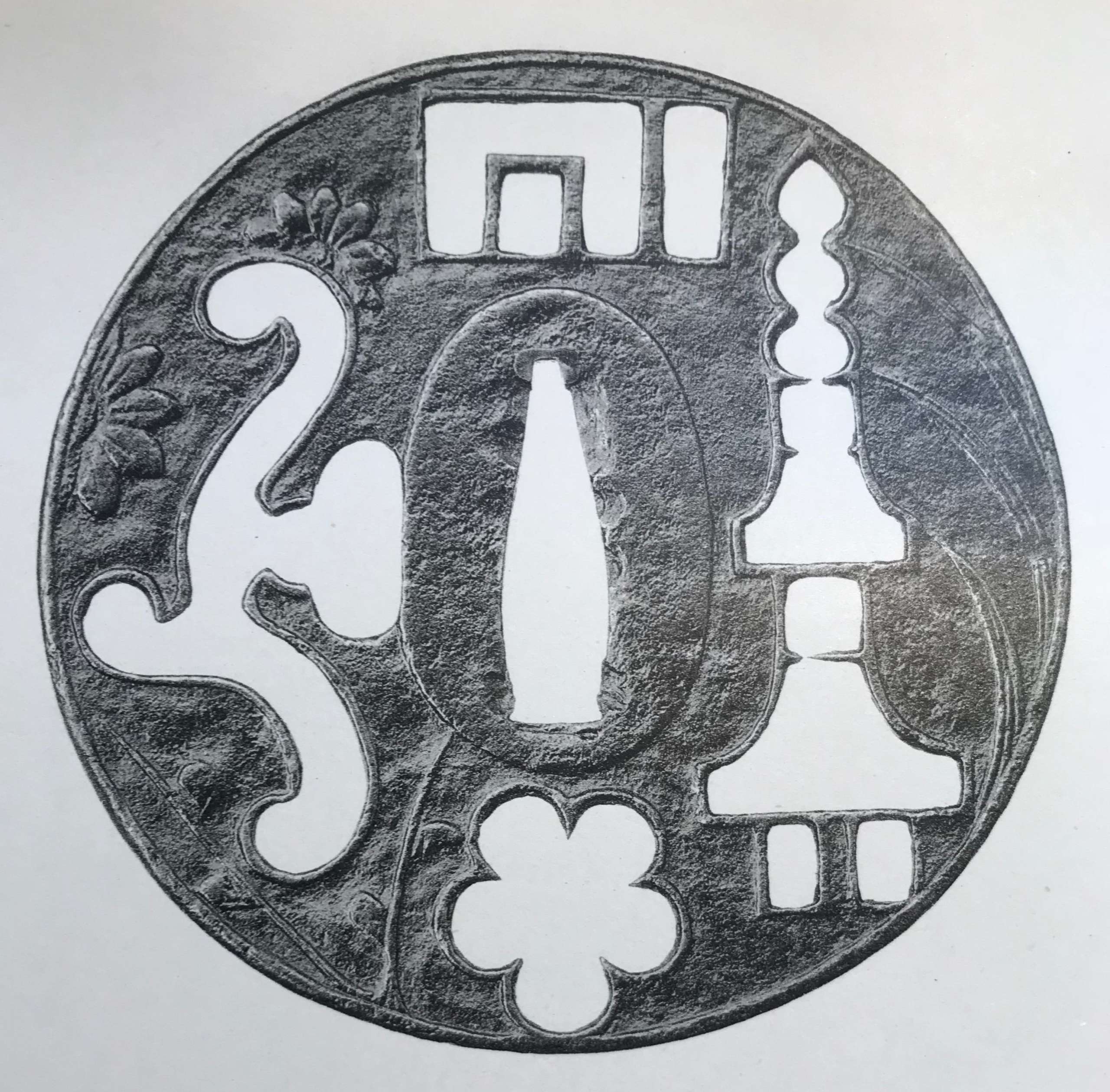
Japanese Sword Fittings. Collection of G.H. Naunton, Esq., by Henri L. Joly, - 1912; №9.
-
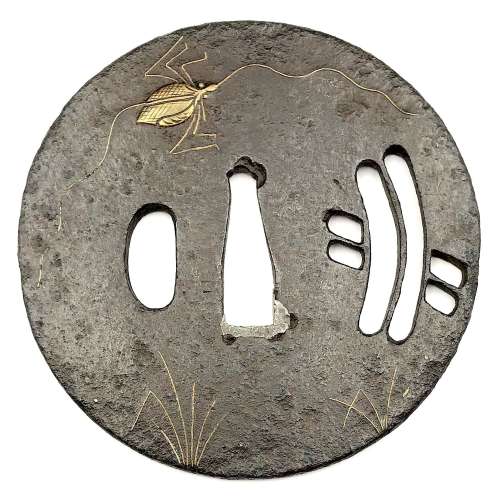 Iron tsuba with design of a cricket and grass inlaid in brass (suemon-zōgan) and a bridge over a stream in openwork (sukashi) on both sides. Inlay of distant part of the cricket's antenna is missing. Heianjō School. Momoyama period. Diameter: 79.5 mm, thickness at seppa-dai: 3.3 mm NBTHK # 4002100.
Iron tsuba with design of a cricket and grass inlaid in brass (suemon-zōgan) and a bridge over a stream in openwork (sukashi) on both sides. Inlay of distant part of the cricket's antenna is missing. Heianjō School. Momoyama period. Diameter: 79.5 mm, thickness at seppa-dai: 3.3 mm NBTHK # 4002100. -
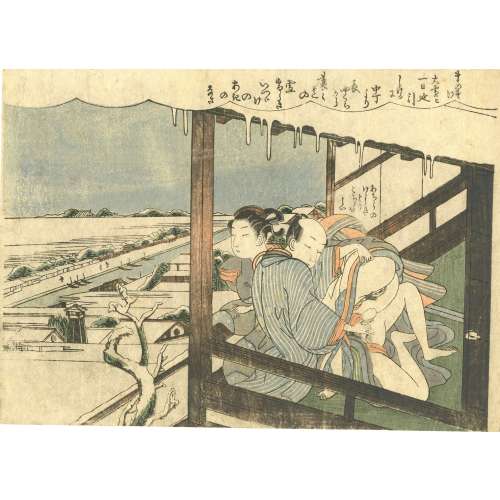 Unsigned print, attributed to Suzuki Harunobu. Erotic scene on open veranda with a winter landscape on background.
Unsigned print, attributed to Suzuki Harunobu. Erotic scene on open veranda with a winter landscape on background. -
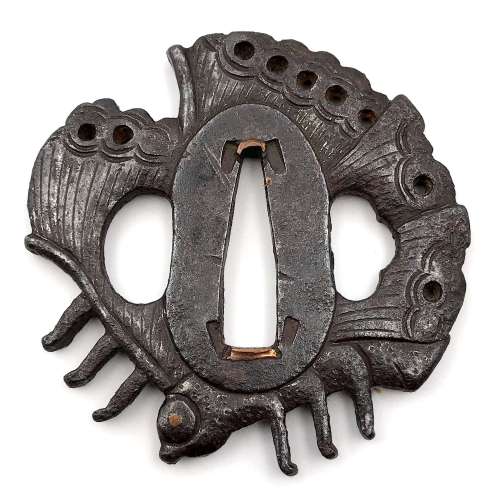 This tsuba is a cut from a typical Bizen Shōami butterfly tsuba (see TSU-0100 in this collection), which normally would have had a circular rim around the butterfly. In this particular example of altered guard we have both eyes of the insect (inlaid in brass or copper) intact. The kebori carving is more pronounced than in TSU-0100 example. Copper sekigane. Unsigned. Attributed to Bizen Shōami school, early Edo period (17th century). Dimensions: 64.7 x 63.7 x 5.2 mm References: see TSU-0100.
This tsuba is a cut from a typical Bizen Shōami butterfly tsuba (see TSU-0100 in this collection), which normally would have had a circular rim around the butterfly. In this particular example of altered guard we have both eyes of the insect (inlaid in brass or copper) intact. The kebori carving is more pronounced than in TSU-0100 example. Copper sekigane. Unsigned. Attributed to Bizen Shōami school, early Edo period (17th century). Dimensions: 64.7 x 63.7 x 5.2 mm References: see TSU-0100. -
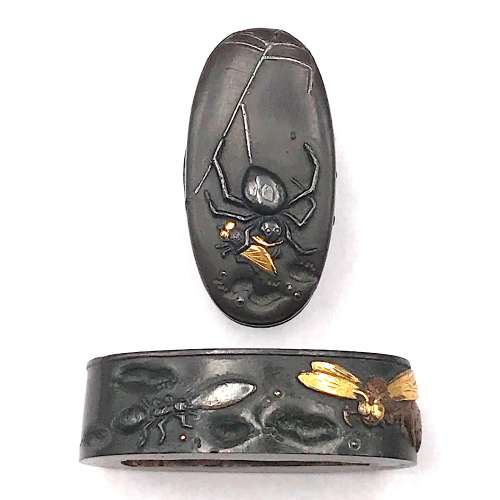
Fuchi-kashira made of Shibuichi carved and inlaid with shakudō, gold, silver, and copper with the design of spider holding a fly on the fuchi, and other insects (ant-lion, wasp, and ant) on the kashira.
Fuchi: 35.1 mm. Kashira: 38.7 mm. Main material: Shibuichi. Other metals: shakudō, gold, silver, and copper. Decorative technique: iroe taka-zōgan. -
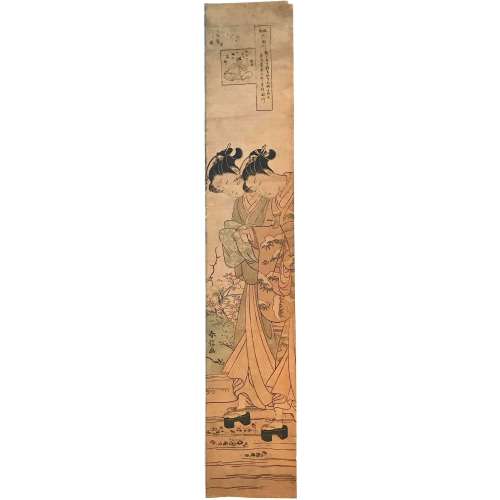 Suzuki Harunobu (鈴木 春信; c. 1725 – 15 July 1770).
Suzuki Harunobu (鈴木 春信; c. 1725 – 15 July 1770).The Ide Jewel River, a Famous Place in Yamashiro Province (Ide no Tamagawa, Yamashiro no meisho), from the series The Six Jewel Rivers in Popular Customs (Fûzoku Mu Tamagawa).
Signed: Harunobu gaInscription - Poem: Koma tomete/ nao mizu kawan/ yamabuki no/ hana no tsuyu sou/ Ide no Tamagawa
References:MFA # 21.4540.
Waterhouse cat. #562; Pins, The Japanese Pillar Print (1982), #139; Ukiyo-e shûka 4 (1979), list #795.4, and supp. 2 (1982), pl. 565; Gentles, AIC cat. II (1965), p. 125, #201.
-
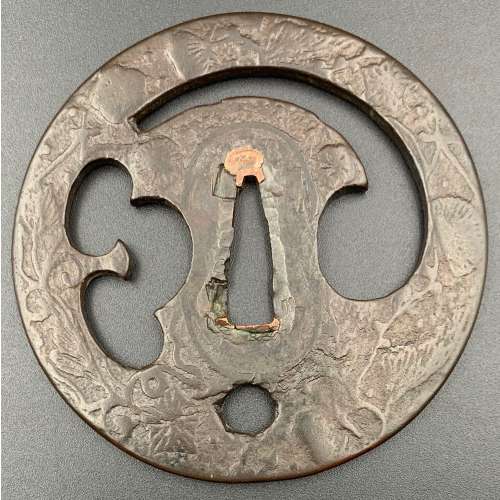
Yamagane (bronze) tsuba (kagami-shi, or mirror-maker) with the design of a star (round opening), tomoe (comma), and suhama in openwork. Surface cast and chiselled with the design of foliage, vines, blossoms, pine needles, and fruits on both sides.
The end of Early Muromachi period (1393-1453), circa 1450. Size: 83.7 x 84.1 x 3.6 (center), 4.1 (rim) mm; weight: 135.5 g. KANTEI-SHO (鑑定書) - APPRAISAL [translated by Markus Sesko]. No 463341 Tomoe-suhama-sukashi hana-karakusa no zu tsuba (巴洲浜透花唐草図鐔) ‒ Tsuba with stylized comma and bay inlet openwork and a flower and arabesque décor Unsigned: Kagami-shi (鏡師) Round shape, yamagane, hammer blow finish, cast, negative openwork design, round rim. According to the result of the shinsa committee of our society, we judge this work as authentic and rank it as Hozon Tōsōgu. July 1, 2011 [Foundation] Nihon Bijutsu Tōken Hozon Kyōkai, NBTHK (日本美術刀劍保存協會)



